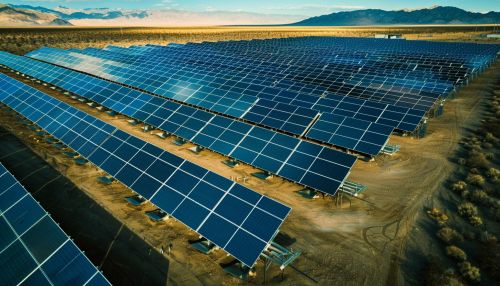Solar power in Nevada: Difference between revisions
(Created page with "== Overview == Solar power in Nevada is a rapidly growing sector within the state's energy portfolio. Nevada's abundant sunshine and favorable regulatory environment have made it a prime location for solar energy development. This article delves into the history, current status, technological advancements, economic impact, and future prospects of solar power in Nevada. == History of Solar Power in Nevada == Nevada has a long history of solar energy utilization, dating...") |
No edit summary |
||
| Line 15: | Line 15: | ||
Nevada is home to several large-scale solar power projects. One of the most notable is the [[Copper Mountain Solar Facility|Copper Mountain Solar Facility]], which is one of the largest photovoltaic plants in the United States. Other significant projects include the Crescent Dunes Solar Energy Project, which utilizes concentrated solar power (CSP) technology, and the Boulder Solar Project. | Nevada is home to several large-scale solar power projects. One of the most notable is the [[Copper Mountain Solar Facility|Copper Mountain Solar Facility]], which is one of the largest photovoltaic plants in the United States. Other significant projects include the Crescent Dunes Solar Energy Project, which utilizes concentrated solar power (CSP) technology, and the Boulder Solar Project. | ||
[[Image:Detail-91815.jpg|thumb|center|Aerial view of a large solar farm in the Nevada desert.|class=only_on_mobile]] | |||
[[Image:Detail-91816.jpg|thumb|center|Aerial view of a large solar farm in the Nevada desert.|class=only_on_desktop]] | |||
== Technological Advancements == | == Technological Advancements == | ||
Latest revision as of 12:41, 19 June 2024
Overview
Solar power in Nevada is a rapidly growing sector within the state's energy portfolio. Nevada's abundant sunshine and favorable regulatory environment have made it a prime location for solar energy development. This article delves into the history, current status, technological advancements, economic impact, and future prospects of solar power in Nevada.
History of Solar Power in Nevada
Nevada has a long history of solar energy utilization, dating back to the early 20th century when solar water heaters were first introduced. However, significant development in solar power began in the late 20th century with the advent of photovoltaic (PV) technology. The state's commitment to renewable energy was solidified with the passage of the Renewable Portfolio Standard (RPS) in 1997, which mandated that a certain percentage of the state's electricity come from renewable sources, including solar.
Solar Resources and Potential
Nevada is one of the sunniest states in the U.S., receiving an average of over 300 days of sunshine per year. This high solar insolation makes it an ideal location for both utility-scale and distributed solar power projects. The state's vast desert areas offer ample space for large solar farms, while urban areas have significant potential for rooftop solar installations.
Major Solar Projects
Nevada is home to several large-scale solar power projects. One of the most notable is the Copper Mountain Solar Facility, which is one of the largest photovoltaic plants in the United States. Other significant projects include the Crescent Dunes Solar Energy Project, which utilizes concentrated solar power (CSP) technology, and the Boulder Solar Project.


Technological Advancements
The solar power industry in Nevada has seen numerous technological advancements. These include improvements in PV cell efficiency, the development of bifacial solar panels that can capture sunlight from both sides, and advancements in CSP technology. Energy storage solutions, such as lithium-ion batteries, are also being integrated with solar power systems to provide a more reliable and stable energy supply.
Economic Impact
The solar power industry has had a significant economic impact on Nevada. It has created thousands of jobs in construction, manufacturing, and maintenance. Additionally, solar projects have generated substantial tax revenue for local governments and have contributed to the diversification of the state's economy. The cost of solar power has also decreased dramatically, making it a more competitive option compared to traditional fossil fuels.
Regulatory Environment
Nevada's regulatory environment has been conducive to the growth of solar power. The state has implemented several policies to encourage solar energy development, including net metering, tax incentives, and grants. The Public Utilities Commission of Nevada (PUCN) plays a crucial role in regulating the state's energy market and ensuring that solar power projects comply with state and federal regulations.
Challenges and Barriers
Despite its many advantages, the solar power industry in Nevada faces several challenges. These include the intermittency of solar energy, which requires effective energy storage solutions, and the need for significant investment in grid infrastructure to accommodate the influx of solar power. Additionally, there are environmental concerns related to the land use and water consumption of large solar farms.
Future Prospects
The future of solar power in Nevada looks promising. The state has set ambitious goals for renewable energy, aiming to achieve 50% renewable energy by 2030 and 100% by 2050. Continued advancements in solar technology and energy storage, along with supportive policies, are expected to drive further growth in the sector. Additionally, the development of community solar projects and the expansion of rooftop solar installations will likely play a significant role in the state's renewable energy future.
